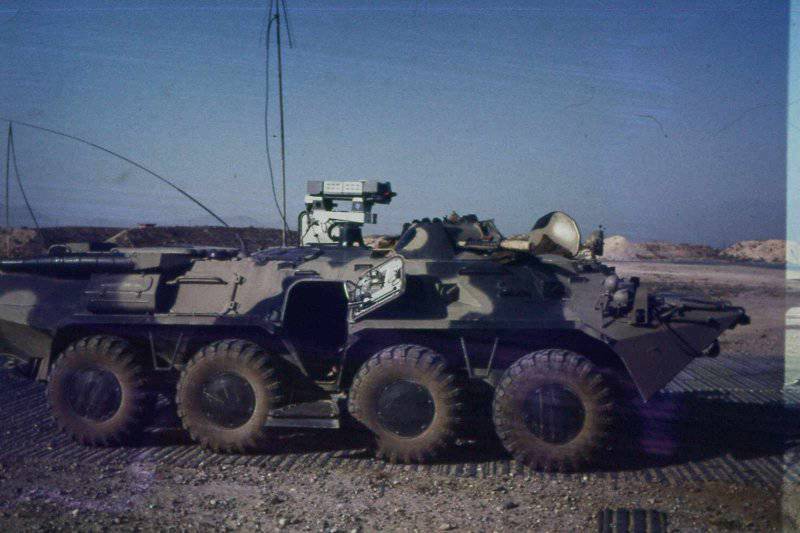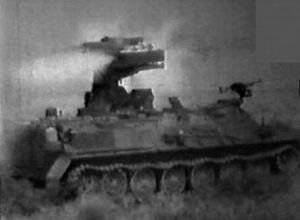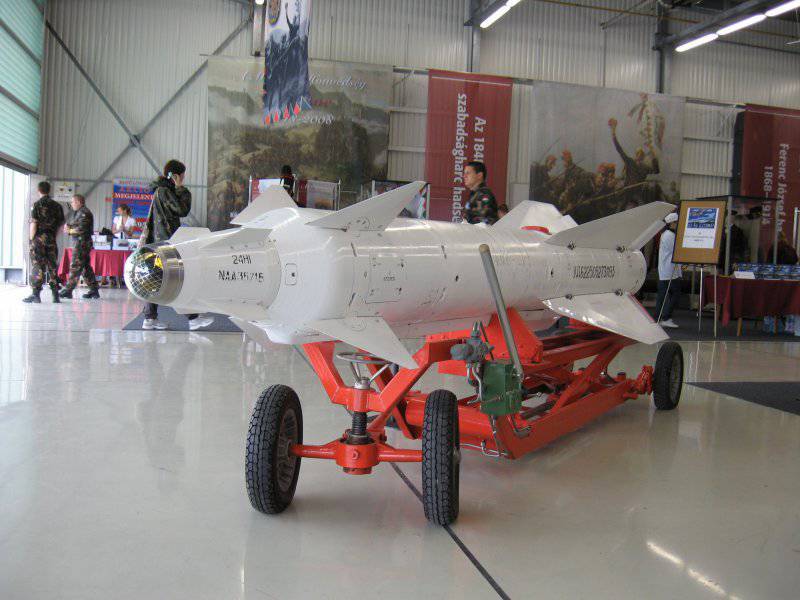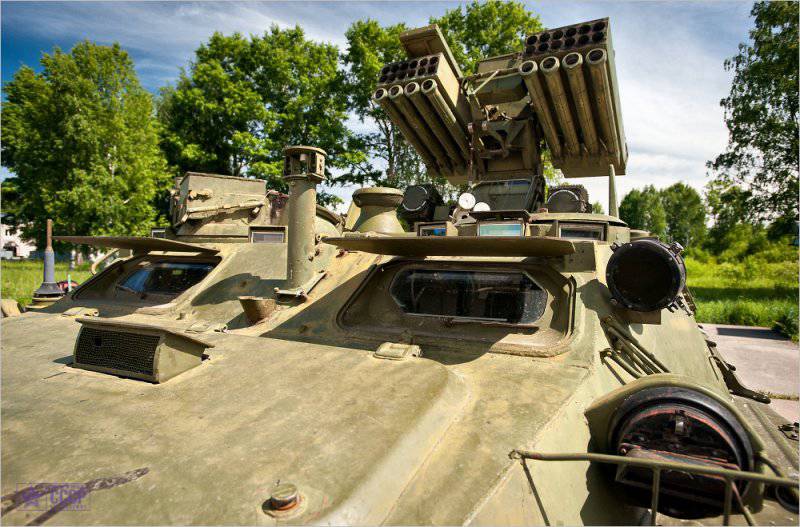To help the pilots. Aircraft gunners combat vehicles
Despite all the advantages of guided missiles, their use by Su-25 attack aircraft had several characteristic features that made combat work difficult. The plane’s pilot had to independently detect the target, mark it with the help of the Klen-PS laser illumination and distance metering station, and then, holding the laser beam on the target, launch the rocket. In addition, it was necessary to pilot the aircraft and in a combat situation launching rockets became a very difficult task. Moreover, under certain circumstances, the attack pilot could not at all independently find a small disguised target and attack it. For this reason, for example, the results of the first use of guided missiles in April 1986 of the year under Khost, although they were found to be satisfactory, remained mixed. Maneuvering in the mountains, coupled with the search and attack targets, was a very difficult task, even for experienced pilots.
Brainchild troop workshops
For several months, the pilots and technicians of the 378, oshap, were looking for a way to get rid of the existing difficulties and to ensure the proper usability of laser-guided missiles. The solution was simple and original. Already in the first months of the next 1987, the technical composition of the regiment, together with several specialists summoned from the Soviet Union, was specially modified by the newest serial BTR-80 armored personnel carrier. The essence of the idea and rework of the armored vehicle was that the pilot-attack aircraft removed the responsibility for finding the target and its illumination with a laser beam. These tasks now had to perform the crew of the modified armored personnel carrier. After the conversion, the BTR-80 received a new designation BOMAN (“Airborne Gunner Fighting Vehicle”).

One of the BOMAN collected in 378-oshap. Based on its appearance, we can assume that this is the very first instance of such a machine.
When reworking on the roof of the car (behind the tower, between the upper hatches of the hull) a simple pedestal with fastening and guidance mechanisms was installed. On the latter, the Klen-PS laser station, taken from the decommissioned Su-25 attack aircraft, was mounted. For aiming the laser beam, we used a sight borrowed from the heavy-bore machine gun NSV "Utes". Inside the corps of the former armored personnel carrier equipped the workplace of the systems operator, among other things, equipped with an additional radio station to communicate with the attack aircraft. All new electronic systems are connected to the general electric systems of the armored car.
New car "handicraft" manufacturing was supposed to be used as follows. While the Su-25 attack aircraft, armed with X-25 or X-29L missiles, is heading towards the target, the BOMAN takes up a position with a direct visibility of the target. Then the gunner operator searches for the target and directs the Klen-PS station to it. When the attack aircraft approached the attacked object at a sufficient distance and is ready to attack, it informs the operator of the BOMAN machine. That includes the laser and keeps the beam on target. The pilot remains to wait for the rocket to capture the illuminated target and launch. Under ideal conditions, with this method of attack, the plane or the gunner’s machine could be at a great distance from the target, without putting themselves at risk of being attacked in response. However, according to some sources, in a real combat situation the BOMAN vehicles often approached the target at the minimum possible distance, due to which the reflected light of the laser was stronger and the rocket confidently captured the target. In addition, the defeat of the enemy object was facilitated by the fact that during target designation the gunner’s machine stood firmly in position. Due to this, holding the laser mark in one place was not a big deal.
In the 1987 year, in accordance with the order of the Air Force Commander of the 40 Army, Major-General D. Romanyuk, the BOMAN underwent a real military operation. Su-25 attack aircraft under the control of Lieutenant Colonel N. Dikoy (378-th error) and Lieutenant-Colonel M. Pudovkin (pilot-inspector of the 40 army) made a total of 75 flights with the launch of guided missiles. Test flights with target designation from the ground were carried out with the purpose of air support of troops during operations in the Aliheil region, near the border with Pakistan. In total, during the war in Afghanistan, Soviet pilots used several types of guided missiles around 140.
The effect of processing the newest armored personnel carrier fully justified all the costs. The attackers, acting together with the aircraft gunner’s combat vehicle, were guaranteed to hit targets, including those that were rather difficult to destroy with other weapons. For example, with proper and not too complicated organization of joint work, the pilots and the gunner managed to get a rocket exactly into the entrance of the cave. If an improvised ammunition depot was located in such a natural shelter, the effect was stunning.
Probably, the gunner’s desire to get closer to the goal indirectly served as a reason for creating a new BOMAN. The fact is that the enemy rather quickly realized that the appearance of an armored personnel carrier with some equipment on the roof was a harbinger of a quick attack of attack aircraft. In order not to expose the electronics of the Klen-PS station to risk and not to unmask the car, already in 1987, work began on the construction of the second version of the BOMAN. According to various sources, this time the BTR-70 armored personnel carrier became the basis for the aircraft gunner’s combat vehicle, however, information on the use of the BTR-80 was also found. Regardless of the specific model of basic armored vehicles, the second version of the BOMAN received an updated system for installing laser equipment. This time, the 378 vehicles oshap assembled a lifting mechanism that allowed the lighting station to be removed inside the armored hull.
The exact number of BOGS manufactured at Soviet bases in Afghanistan is not known. In different sources there are numbers from two (one car of each variant) to 5-7. Anyway, the new class of armored vehicles quickly showed their potential and their need. Seeing the capabilities of Su-25 attack aircraft getting target designation from the ground, the Mujahideen began a real hunt for armored personnel carriers with Klen-PS stations. Fortunately, these machines turned out to be a very difficult goal and, as far as we know, none of them was lost or seriously damaged by enemy fire.
Universal BMA
 The high efficiency of aviation gunner machines manufactured in military workshops led to the emergence of a new technology of a similar purpose. At the very end of the eighties, in the 344-th Center for the combat use and retraining of flight personnel (Torzhok), another aircraft engineer vehicle was created under the direction of Colonel V. Archegov, which received the BMA index (also known as BMAN). When creating this project, the main disadvantage of the "Afghan" BOMAN was taken into account - their narrow specialization. The BMA from Torzhok was to become more universal: it was required not only to assist in guiding the guided missiles, but also to carry out the overall coordination of the work of strike aircraft and helicopters.
The high efficiency of aviation gunner machines manufactured in military workshops led to the emergence of a new technology of a similar purpose. At the very end of the eighties, in the 344-th Center for the combat use and retraining of flight personnel (Torzhok), another aircraft engineer vehicle was created under the direction of Colonel V. Archegov, which received the BMA index (also known as BMAN). When creating this project, the main disadvantage of the "Afghan" BOMAN was taken into account - their narrow specialization. The BMA from Torzhok was to become more universal: it was required not only to assist in guiding the guided missiles, but also to carry out the overall coordination of the work of strike aircraft and helicopters.The Strela-10 anti-aircraft missile system based on the MT-LB light armored chassis was used as the basis for the new BMA. From the original ZRK dismantled all equipment for the transport and launch of missiles, and in its place installed new guides. On the upper part of the turret, mounted two units BKP-B812, designed for 12 unguided missiles C-8 caliber 80 millimeters. It is likely that for targeting it was supposed to use lighting and marking (smoke) unguided missiles of the C-8 and C-8ЦМ models, respectively. Under the guiding blocks for the C-8 missiles, one 2P130-3 launcher was installed for the 90М9 Illumination 41-mm illumination missiles. It is noteworthy that these launchers were borrowed from Mi-24 helicopters. Finally, two infrared searchlights, apparently taken from the Blind-1 tank complex, were installed on the sides of the operator’s tower. In addition to the guides for rockets and searchlights, the BMA machine received a set of electronic equipment for communication with front-line pilots. For self-defense, it was armed with a single machine gun mounted in front of the commander's hatch in front of the hull.
With the help of electronic equipment and launchers, the new BMA could find targets on the battlefield and transmit information about them to strike aircraft and helicopters. In addition, if necessary, the aircraft carrier from the BMA crew could mark the target with the C-8TM marking missile or illuminate the required territory with other ammunition. The searchlight of the “Curtain” system was probably supposed to be used to illuminate the battlefield in the infrared range. On the possibility of illumination of the target using a laser accurate data are not available. On the existing photos of the BMA above one of the packages of the guides are visible some devices for the installation of some equipment. Perhaps the BMA was supposed to carry the light station, similar to the "Maple-PS".
During the development of a new version of the universal air vehicle of the air gunner, it was assumed that such equipment will appear in every motorized and tank battalion in the coming years. With its BMA, ground units could more effectively interact with strike aviation, which would lead to a marked increase in their combat capabilities. Approximately in 1990, the BMA machine went into series. The assembly of equipment began at one of the factories of the Kazakh SSR, but the exact location of the production remains questionable: various sources indicate the enterprises of Almaty and Uralsk. The same uncertainty exists in relation to the number of built BMA. Before the collapse of the Soviet Union, the defense industry managed to manufacture from 20 to 50 military aircraft designed by V. Archegov.
After the USSR ceased to exist, the construction of such equipment for the ground forces ceased. The further fate of the built cars is not exactly known, but, judging by the fragmentary data, the BMA was used to a limited extent in the ground forces. After using up the resource they were written off. At least one aircraft gunner machine has survived to the present and is located in the 344-th Center for Combat Use in Torzhok. The rest, most likely, were disposed of or transferred to the storage bases.
***
"Afghan" BOMAN and BMA, designed in Torzhok, became the only representatives of their class in the Soviet and Russian armed forces. This class of equipment appeared rather late and, due to the difficult economic and political situation in the country, could not take its place. Even built BMA because of the mass of problems of very different nature have worked their resources and were written off, not having had time to seriously help front-line aviation.
At present, special attention is being paid to guided aircraft weapons. Among other types of homing heads for high-precision missiles and bombs, semi-active laser systems are also preserved. Despite the emergence of a number of new ideas and technologies, in some cases, an aircraft manufacturer combat vehicle equipped with a laser backlight station could have a great influence on the course of aviation combat operations. As for the universal BMA machine, its capabilities are also high enough to neglect them. It cannot be ruled out that in the future the domestic military department will again return to a forgotten idea, but so far other methods have been used to target aircraft and helicopters to the target.
Based on:
Markovskiy V.Yu., Prikhodchenko I.V. Su-25 “Rook” attack aircraft. Armored heir IL-2 - M .: Yauza: Eksmo: 2011
http://vertopedia.ru/
http://shushpanzer-ru.livejournal.com/
http://russianarms.mybb.ru/
http://vadimvswar.narod.ru/



Information